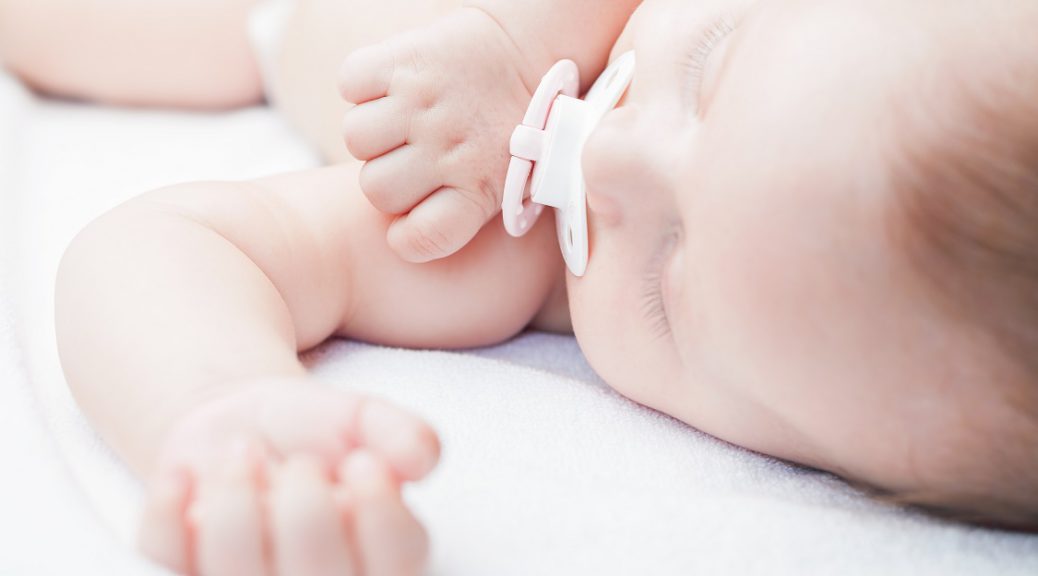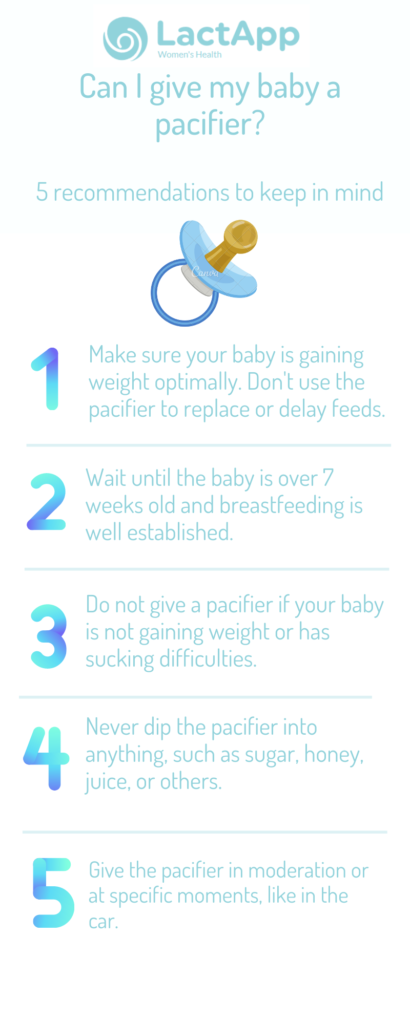
Pacifier and breastfeeding: can I give my baby a pacifier?
Why is sucking so important for babies?
Babies begin to develop the sucking reflex while still in their mother’s womb; this is a very important learning process that will allow them to feed as soon as they are born. So, one of the main functions of sucking is undoubtedly feeding. But does this sucking reflex have any other functions?
Of course, sucking also has a restorative function for babies. Sucking produces a great deal of well-being in babies. When a baby sucks, their brain releases endorphins, pleasure hormones, which immediately relax and comfort them.
Therefore, the breast is not only a source of nourishment, but it allows babies to calm down, fall asleep, feel safe, and feel loved. We have to keep in mind that babies do not only eat when they suckle the breast, and this is important to remember because, many times, when a baby seems to be “too long” at the breast, many mothers get the same mistaken message: “your baby uses you as a pacifier.“
The first model of a pacifier was patented in the United States in 1900, and it is clear that its name honors its function: to soothe a baby. Today it’s also called a dummy or teat in places like the UK, Australia, and New Zealand. Although the pacifier was patented around this time, primitive pacifiers are known to date back to 1,000 BC. But even though pacifiers are not new in our society, their use is, without a doubt, almost generalized, and it seems that they are absolutely necessary to a baby’s life. But as we like to put it:
Babies don’t use the breast as a pacifier, but they use the pacifier as a mother.
What are the advantages and disadvantages of giving a pacifier?
That said, whether or not to give a pacifier is a parenting choice. Each family decides what they want to do, with the information on the advantages and disadvantages of using a pacifier.
Disadvantages:
- The pacifier should not be given before 6-7 weeks of age, as it can interfere with a good establishment of breastfeeding.
- Sucking the pacifier makes them feel full, which can be dangerous if the baby loses weight or does not gain weight appropriately.
- If you feel pain during breastfeeding, it is important to look for and solve the causes with a good follow-up and not use the pacifier to skip feeds, as this can be dangerous for the baby.
- Just like bottle teats, pacifiers can also produce sucking modifications.
- They can cause dependency.
- They can cause dental problems.
- The AAP (American Association of Pediatrics) and other organizations recommend eliminating pacifiers in infants before one year old.
Advantages:
- It may help premature or hospitalized babies who are separated from their mothers to feel better.
- In premature babies, it seems to help improve nutritional sucking.
- It can be a help when making car journeys.
- The use of the pacifier is especially recommended for formula-fed babies as a protective factor against SIDS (Sudden infant death syndrome). But a baby who breastfeeds on demand does not need to suck anything else to prevent this risk.
As an alternative to the pacifier, you can also use your finger; remember to wash your hands clean and cut your fingernail short. Place your finger lightly against the baby’s palate, and the baby will start sucking immediately.

We also asked the dentist and lactation expert Irene Iglesias* about the use of pacifiers:
“The pacifier, as an external element to the body, can be used but with the knowledge that it entails risks as well as benefits. Experts seem to agree (although I have heard some disagreeing voices) that it can be used once breastfeeding is established so as not to confuse the baby.
The risk-free use of the pacifier implies that it is the adult who controls it and not the baby. It can be given in a stressful situation for the baby, such as going in a car. But it is the adult who gives it, and it is the adult who must take it away once the situation of anxiety has passed.
It should not be attached to clothing with the typical clip and chain because leaving it at the free disposal of the child to use, is one of the risk factors for making it difficult to remove the pacifier later on.
Silicone pacifiers are preferable because they are more hygienic, and as for the shape of the teat, cherry-shaped ones should be avoided.
The part between the teat and the base of the pacifier should be as thin as possible in order to avoid the appearance of an open bite.
The use of the pacifier for less than 6 hours a day does not seem to produce negative effects on the dental occlusion of the child.
But its use beyond 3 years of age is related to alterations in the growth of the craniofacial structure, affecting the bones and muscles of the face, especially producing anterior open bite (when the mouth is closed, there is a space between the upper and lower teeth) and posterior crossbites. As well as the time of use, the intensity of use is also important. A child who uses it by sucking gently does not produce the same effect as one who keeps it and does not let go under any circumstances.
At around 2 years of age, if the child continues to use the pacifier, it is necessary to consult with the dentist and assess the child’s facial growth. In many cases, the time can be extended until 3 years of age, and in others, there are already malformations that will increase. Children who continue to use the pacifier beyond 3 years of age are likelier to have harmful habits such as chewing pencils or fingernails and so on. A recent study has even found more smokers among those adults who used the pacifier longer as children. The best prevention of orofacial malformations, including malocclusions, is breastfeeding for as long as possible and a consistent, hard, and rich-in-fiber diet to stimulate bone growth, optimal calcification of the bones and the harmonious growth of muscles, bones, and joints, thus favoring a correct positioning of the teeth”.
We hope these lines will help you to have more information and make the most suitable decision in your situation. Whether you choose to offer the pacifier to your baby or not, we must insist that this is a personal matter and that each family is free to raise their children as they think best and can.
If you have any more questions about this, please download LactApp, for iPhone or Android. In the contact section of the app, you can find an in-app consultation channel, where our experts will answer your questions.